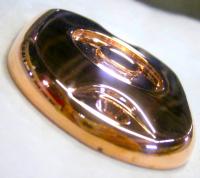
Photo from wikipedia
The electrode processes occurring during electrodeposition of nanocrystalline Fe-W alloy coatings from a citrate bath containing iron(II) sulfate and a tungstate (pH 6.9; 80°C, graphite anode) are studied by cyclic… Click to show full abstract
The electrode processes occurring during electrodeposition of nanocrystalline Fe-W alloy coatings from a citrate bath containing iron(II) sulfate and a tungstate (pH 6.9; 80°C, graphite anode) are studied by cyclic voltammetry. The current efficiency of alloy electrodeposition is up to 30%, if the applied current density is confined to the range of 2–5 A/dm2. The limitation on range of applied current densities is twofold: the lower limit is dictated by the diffusion-limited current density due to the reduction of the oxidized form of iron-citrate complex that forms at the bath preparation stage as a result of oxidation of Fe(II) species in a citrate solution; while the upper limit is imposed by the occurrence of side reactions such as the hydrogen evolution reaction and/or reduction of organic components of the bath. The use of an iron anode seems to be promising in this deposition process (the current efficiency of anodic dissolution of Fe in this bath is 93 ± 2%). The deposited coatings contain ~25 at % tungsten and their microhardness (which can be up to 900 kgF/mm2) depends on the volume current density. The studied system holds promise for application in mask-free localized electrodeposition.
Journal Title: Surface Engineering and Applied Electrochemistry
Year Published: 2019
Link to full text (if available)
Share on Social Media: Sign Up to like & get
recommendations!